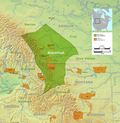Blood 148 | |
|---|---|
| Blood Indian Reserve No. 148 | |
 James Gladstone on his combine harvester | |
 Location in Alberta | |
| First Nation | Kainai Nation |
| Country | Canada |
| Province | Alberta |
| Municipal district | Cardston |
| Headquarters | Stand Off |
| Government | |
| • Body | Blood Tribe Council |
| • Chief | Travis Plaled Hair |
| Area | |
• Total | 1,413.87 km2 (545.90 sq mi) |
| Population (2021) [1] | |
• Total | 4,572 |
| Time zone | UTC−7 (MST) |
| • Summer (DST) | UTC−6 (MDT) |
| Area code | 403 |
| Highways | Highway 2 Highway 5 Highway 509 |
| Website | bloodtribe |

Blood 148 is a First Nations reserve in Alberta, Canada. It is inhabited by the Blood (Kainai) First Nation and was established under the provisions of Treaty 7. [2] This reserve is managed from the community of Stand Off on its northwest border and encompasses the majority of lands bounded by the cities of Fort MacLeod, Lethbridge and Cardston. It is traversed by Alberta Highway 2, Highway 5, and Highway 509. The St Mary River and the Belly River are major rivers supplying and draining the lands.
Contents
At 1,413.87 km2 (545.90 sq mi), the Blood 148 reserve is the largest reserve by land in Canada, and the third most populous after Six Nations and Akwesasne. On June 12, 2019, federal courts ruled that, according to the land entitlement provisions of Treaty 7, the Blood Tribe was entitled to a reserve equal to 710 square miles (1,800 km2) in area, [3] an increase of 164.1 square miles (425 km2) over the existing lands. The judgement did not address remedy nor costs. It is located between the Cities of Fort MacLeod and Lethbridge and the Town of Cardston, bordering the Municipal District of Willow Creek No. 26 to the northwest, the Lethbridge County to the northeast and Cardston County to the east, south and southwest.

